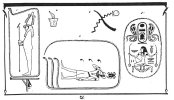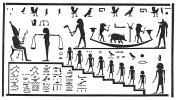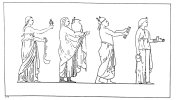
Masonic, Occult and Esoteric Online Library
The Hieroglyphics of Horapollo
By
Appendix
EXPLANATION OF THE PLATES.
The FRONTISPIECE is a Ptolemaic doorway, with the supreme god, Ammon, upon its piers, holding in one hand the staff of power, and in the other the emblem of life. The sacred symbol of the. Winged Globe and Serpent is upon the architrave: and a continuous row of serpents forms .an attic above the cornice. The symbol in the centre signifies "Hieroglyphics."
PLATE I.
Fig. I. is a representation of the god Atmou surrounded by a serpent with his tail in his mouth, and is given by Dr. Leemans in illustration of book I. chapter 2.
II. Is an illustration of the same chapter; it occurs on a sarcophagus in the British Museum.
III. Is from a scarab seal in the possession of J. Millingen, Esq. It is a representation of Netpe holding two palm branches indicative of the year, and seems to imply that the calendar was reformed by Thothmos III. whose signet occupies the upper half. See chapter 12.
IV. A lamp or pot of fire, signifies the letter B, and may be an illustration of chapter 22.
V. This has not unfrequently been considered. an illustration of book I. chapter 43; but is extremely doubtful.
 Plate I
Plate I
PLATE II.
This plate, sketched by Mr. Bonomi, from a tomb in Thebes, represents a judgment scene in which, as explained by Champollion, different souls are ascending the steps to judgment by Osiris. The soul of a glutton last condemned is departing in the boat in the form of a swine. See book II. chapter 37: and for the inverted stags’ heads, which seem to have some connection with eternity, see book I. chapter 69, and book II. chapter 21. A similar judgment scene appears upon the sarcophagus from Belzoni's tomb in Sir J. Soame's museum.

Plate II

Plate III
PLATE III.
It is evident that in the chapters, 37, 38, 39, 40, 41, and 42, of the first Book, Horapollo must have had in view one of the ceremonial processions of the Egyptian priests.
The plate, a copy of a basso relievo of Roman date, given in Bartoli's Admiranda, represents a similar procession. The following passage from Clemens of Alexandria throws considerably more light upon the subject:
The Egyptians possess a certain native philosophy of their own, and this their sacred ceremonies principally shew. For first proceeds a Singer bearing some of the symbols of music: and they say that his duty is to be versed in the two books of Hermes, one of which contains the hymns of the gods, and the other precepts for the regulation of the king's life. After the singer comes the Horoscopus holding in his hand a clock and a palm branch, the symbols of astrology. His duty is constantly to retain in memory the astrological books of Hermes, which are four in number: of these one treats of the disposition of the apparently fixed stars, another of the conjunctions and illuminations of the sun and moon, and the remaining ones of their rising. After him proceeds the sacred Scribe, having wings upon his head, and in his hands a book and rule containing ink and the reed with which they write. His duty is to be acquainted with what are called hieroglyphics, relating to cosmography, geography, the positions of the sun and moon, the five planets, the topography. of Egypt, the Nile, and its adjacent shores; comprising also a description of the attire of the priests, and of the places set apart for them, and concerning the measures and other matters appertaining to the priests. After the preceding, follows the Stolistes (the Master of the Robes,) holding the rod of justice and the chalice. His duty is to be versed in all things relating to education, and the rites called "the sacrifice of the calf." Ten of these [books] relate to the worship of their gods and the Egyptian religion, viz. such as concern the sacrifices, first fruits, hymns, prayers, processions, festivals, and the like. Last of all comes the Prophet openly carrying in his bosom the waterpot: and he is followed by the supervisors of the exportation of bread. His duty as president of the temple is to be conversant with the ten books called hieratic. These contain all things relating to the laws and the gods, and the entire ordinances respecting sacred matters. For among the Egyptians the prophet presides over the distribution of the revenue; hence there are forty-two books of Hermes which are absolutely necessary. Of these, thirty-six, containing all the philosophy of the Egyptians, are learned by the above-mentioned officers: the remaining six, relating to medicine and the constitution of the body, and to its diseases and organs, and to pharmacy and the eyes, and lastly to woman, are learned by the pastophori.—Clemens. Strom. VI. 633.
The following passages from Clemens of Alexandria and Porphyry are illustrative of the different kinds of writing anciently practised in Egypt. The passage of Clemens is found to be strictly in accordance with the result of modern discoveries, which have brought to light the Enchorial, Hieratic, and Hieroglyphic inscriptions, and the different species of Hieroglyphics.
FROM CLEMENS.
Now those who are instructed by the Egyptians, first of all learn that system of Egyptian writing, which is called the EPISTOLOGRAPHIC [or enchorial]; secondly, the HIERATIC, which is used by the sacred scribes; thirdly and lastly, the HIEROGLYPHIC. Of this [last] one kind expresses its own meaning by the first elements [alphabetically]; but the other kind is symbolical. Of the symbolical, one sort directly conveys its meaning by imitation; another sort is written as it were metaphorically; while the remaining sort speaks allegorically as it were by means of (enigmas. Thus, [Imitatively,] when they would indicate the Sun they make a CIRCLE, and the moon, a CRESCENT by a form which conveys its own signification. But Metaphorically, they adopt some appropriate turn or transfer in their engravings, simply changing some things, but multifariously transforming others: thus in expressing the praises of their kings they invest them with the mythological attributes of the gods, by a transfer of their symbols. But of the third form, the Enigmatical, let this serve as an example: some of the stars, on account of the obliquity of their courses they portray by the bodies of Serpents; but the Sun by that of a Beetle, because it forms a globe of cow-dung, rolling it with its face averted: they say also that this creature lives six months under ground, but the other portion of the year above ground; that it propagates by vivifying the beforementioned globe; and that no female beetle is ever born.—Strom. V. 555.
FROM PORPHYRY.
Pythagoras travelled also among the Egyptians; and in Egypt he lived with the priests, and learned from them the wisdom and language of the Egyptians, and the three kinds of writing, viz. the epistolographic, the hieroglyphic, and the symbolic, the one conveying its meaning directly by imitation, the other allegorically, by means of ænigmas. De Vit. Pyth. p. 8.
